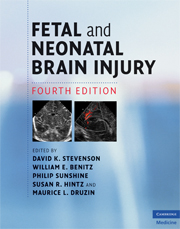Book contents
- Frontmatter
- Contents
- List of contributors
- Foreword
- Preface
- Section 1 Epidemiology, pathophysiology, and pathogenesis of fetal and neonatal brain injury
- Section 2 Pregnancy, labor, and delivery complications causing brain injury
- 5 Prematurity and complications of labor and delivery
- 6 Risks and complications of multiple gestations
- 7 Intrauterine growth restriction
- 8 Maternal diseases that affect fetal development
- 9 Obstetrical conditions and practices that affect the fetus and newborn
- 10 Fetal and neonatal injury as a consequence of maternal substance abuse
- 11 Hypertensive disorders of pregnancy
- 12 Complications of labor and delivery
- 13 Fetal response to asphyxia
- 14 Antepartum evaluation of fetal well-being
- 15 Intrapartum evaluation of the fetus
- Section 3 Diagnosis of the infant with brain injury
- Section 4 Specific conditions associated with fetal and neonatal brain injury
- Section 5 Management of the depressed or neurologically dysfunctional neonate
- Section 6 Assessing outcome of the brain-injured infant
- Index
- Plate section
- References
12 - Complications of labor and delivery
from Section 2 - Pregnancy, labor, and delivery complications causing brain injury
Published online by Cambridge University Press: 12 January 2010
- Frontmatter
- Contents
- List of contributors
- Foreword
- Preface
- Section 1 Epidemiology, pathophysiology, and pathogenesis of fetal and neonatal brain injury
- Section 2 Pregnancy, labor, and delivery complications causing brain injury
- 5 Prematurity and complications of labor and delivery
- 6 Risks and complications of multiple gestations
- 7 Intrauterine growth restriction
- 8 Maternal diseases that affect fetal development
- 9 Obstetrical conditions and practices that affect the fetus and newborn
- 10 Fetal and neonatal injury as a consequence of maternal substance abuse
- 11 Hypertensive disorders of pregnancy
- 12 Complications of labor and delivery
- 13 Fetal response to asphyxia
- 14 Antepartum evaluation of fetal well-being
- 15 Intrapartum evaluation of the fetus
- Section 3 Diagnosis of the infant with brain injury
- Section 4 Specific conditions associated with fetal and neonatal brain injury
- Section 5 Management of the depressed or neurologically dysfunctional neonate
- Section 6 Assessing outcome of the brain-injured infant
- Index
- Plate section
- References
Summary
Introduction
Despite a common misconception among the general public, intrapartum events rarely lead to fetal injury. Approximately 70% of cases of neonatal encephalopathy are secondary to events arising prior to the onset of labor. Moreover, the overall incidence of neonatal encephalopathy attributable to intrapartum hypoxia, in the absence of any other potential preconceptional or antepartum causes, is estimated to be approximately 1.6/10,000. Despite this, the practice of obstetrics is rapidly evolving as a reaction to both extrinsic and intrinsic factors. Today, cesarean section rates are at all-time highs, operative vaginal delivery rates are decreasing, and evidence-based obstetrics is threatened to be replaced by defensive, anecdotally based medicine.
In this chapter, we shall review the available evidence regarding complications of labor and delivery and their potential effects on adverse neonatal injury in general and neurological morbidity in particular. We hope this information will enable physicians to make educated, informed, and rational obstetrical decisions, thereby improving overall patient care.
Cesarean section
In the United States in 2004, 29.1% of live births were via cesarean section. The rate of primary cesarean section in 2004 was 20.6%, compared with 14.6% in 1996. On the other hand, in 2004 the rate of vaginal delivery after previous cesarean (VBAC) was only 9.2%, while in 1996 the rate was 28.3%. The current rise in cesarean section rates is driven by multiple factors including increasing multiple gestations, obstetrical litigation, rising elective cesarean section on maternal demand, advanced maternal age, and decreasing operative vaginal delivery.
- Type
- Chapter
- Information
- Fetal and Neonatal Brain Injury , pp. 134 - 142Publisher: Cambridge University PressPrint publication year: 2009



